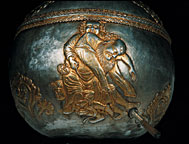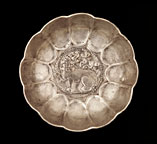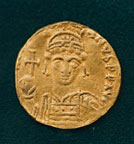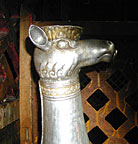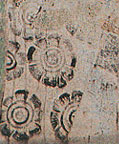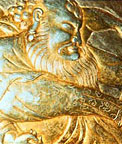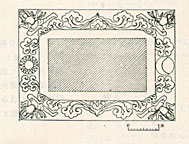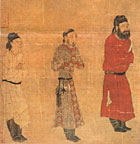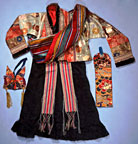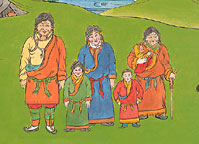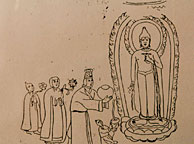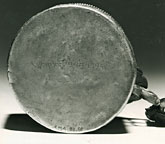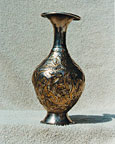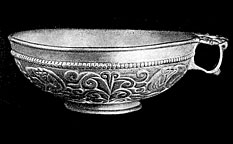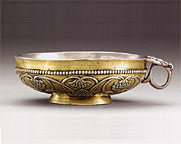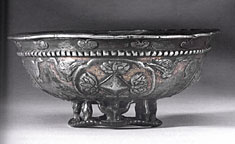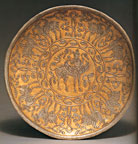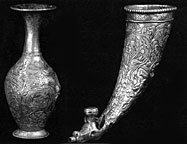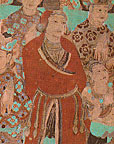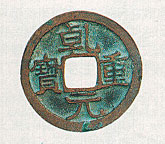|
Selected Bibliography
Anninos,
Tony, "Tokches, Images of Change in early Buddhist Tibet", Orientations
29/9: 93-98 (1998).
Azarpay,
Guitty, Sogdian Painting, Berkeley, 1981.
Backus,
Charles, The Nan chao Kingdom and Tang China's Southwestern
Frontier, Cambridge, 1981.
Beckwith,
Christopher, “ Tibet and the Early Medieval Florissance in Eurasia :
a preliminary note on the economic history of the Tibetan Empire ”
in Central Asiatic Journal, 21/2, 1977 :
89-104.
Beckwith,
Christopher, The Tibetan Empire in Central Asia, Princeton,
1987.
Béguin,
Gilles et Marie Laureillard, Chine, La Gloire des Empereurs,
Réunion des Musées Nationaux, Paris, 2000.
Belenitsky,
Alexandre, L'Asie Centrale Archeologia Mundi, Nagel,
Genève, 1968.
Bunker,
E. "The enigmatic Role of Silver in China" Orientations 1994, vol. 25/11: 73-78.
Carter,
Martha L., “ Three Silver Vessels from Tibet's Earliest Historical
Era : a Preliminary Study ”, Cleveland Studies in the History of Art,
vol. 3, 1998 : 22-47.
Chinese
Numismatics, 2001, vol 4 (issue no. 75). Yan Lin, “ An excavation
of Byzantine gold coins in Wulan county, Qinghai province ”. p. 40
and plate.
Chegini,
N. N. and A.V. Nikitin, “ Sasanian Iran – economy,
society, arts and crafts ” in Litvinsky, B. A., Zhang Guang-da, R.
Shabani Sambhabadi (eds) vol. 3, History
of Civilizations of Central Asia, Delhi, Motilal Banarsidass 1999/
UNESCO 1996
Demiéville,
Paul, Le Concile
de Lhasa, Paris, 1987.
Fifth
Dalai Lama, Catalogue of the Lhasa gTsug lag khang (in
Tibetan), written in 1645 and republished in
Three dkar chag, pp.1-45, 1970, Delhi.
rGyal po bka' thang, recovered by Orgyan gling pa in 1349, reprinted in Lhasa, 1990.
Haarh, Erik, The Yar-lung Dynasty, Copenhagen, 1969.
Harper,
Prudence and Pieter Meyers, Silver
Vessels of the Sasanian Period, The Metropolitan Museum of Art, 1981.
Heller,
Amy, “An Eighth century Child's Garment of Sogdian and Chinese Silks ”
in E. Knight (ed.), Chinese and Central Asian Textiles,
Orientations, Hong Kong, 1998 : 220-222.
Heller,
Amy, Tibetan Art, Tracing the development of Spiritual
Ideals and Art in Tibet, 600-2000 A.D., Jaca Book, Milano, 1999.
Juliano,
Annette and Lerner, Judith, Monks
and Merchants, Silkroad Treasures from Northwest China, Asia Society,
New York, 2001.
Karmay,
Heather (née Stoddard), Early Sino-Tibetan Art, Warminster, 1975
Karmay,
Heather (née Stoddard), “ Tibetan costume, Seventh to Eleventh Centuries ”
in A. Macdonald and Y. Imadea (eds.), Art
du Tibet, Paris, 1977 : 65-81.
Kelley,
Clarence W., “Tang Dynasty Gold and Silver”, Orientations, 16/3, 1985 : pages 10
- 17
Knauer,
Elfriede R. ”Toward a history of the Sleeved Coat ”, Expedition (The University Magazine of Archaeology, Anthropology,
University of Pennsylavania) vol. 21 (1) :18-36. 1978.
Knauer,
E. R. The Camel's Load in Life and
Death, Acanthus, Zurich, 1998.
Knauer,
Elfriede R. “ Le vêtement des Nomades Eurasiatiques et sa Postérité ”,
Académie des Inscriptions et Belles-Lettres, Comptes
rendu des Séances de l'Année 1999, novembre-décembre, Paris, 1141-1187.
Knauer,
E. R. "A Man's Caftan and Leggings from the North Caucasus of the
Eighth to Tenth Century: A Genealogical Study", Metropolitan Museum Journal, vol. 36/ 2001: 124-154.
Lin
Meicun “ Some Persian and Central Asian Silver wares with Inscriptions
from China ” Wenwu, 1997 (9) : 55-65.
Luo,
Feng, “A Central Asian style Gilt-silver
Ewer ” Orientations 29/7: 28-33
(1998)
Litvinsky,
B. A., Zhang Guang-da, R. Shabani Sambhabadi (eds) vol. 3, History
of Civilizations of Central Asia, Delhi, Motilal Banarsidass 1999/
UNESCO 1996
Mahler,
Jane Gaston, The Westerners
among the Figurines of the Tang Dynasty of China, Romae, Serie Orientale
Roma (20), Roma, 1959.
Marshak,
Boris I. “ Sogdian civilisation ” in Litvinsky, B. A., Zhang
Guang-da, R. Shabani Sambhabadi (eds) vol. 3, History
of Civilizations of Central Asia, Delhi, Motilal Banarsidass 1999/
UNESCO 1996
Marshak,
Boris I. “ A Sogdian Silver Bowl in the Freer Gallery of Art ”,
Ars Orientalis 19 : 103-110 (1999).
Marshak,
Boris I. “ The Decoration of some Late Sasanian Silver Vessels and
its Subject-Matter ” in V. S. Curtis, R. Hillenbrand, and J. M. Rogers
(eds), The Art and Archeology of Ancient Persia, London, 1998 : 84-93.
Marshak,
Boris I. "Ewer showing Greek Mythological scenes" in Juliano,
Annette and Lerner, Judith, Monks and Merchants, Asia Society, New York,
2001: 99-100.
Meyers, Pieter, "Technical study" in Harper, Prudence O. and
Meyers, Pieter, Silver Vessels of the Sasanian Period, volume one: royal
imagery, The Metropolitan Museum of Art, New York, 1981: 143-184.
Meyers, Pieter, "Technical
Examinations of Sasanian silver objects in Riggisberg" in Otavsky,
Karel (ed.) Entlang der Seidenstrasse, Riggisberg,
1998: 239-246.
Otavsky,
Karel (ed.) Entlang der Seidenstrasse, Riggisberger
Berichte, Abegg Stiftung, Riggisberg (Bern) 1998.
Overlaet,
Bruno (ed.) Splendeurs des Sassanides. L'empire Perse entre Rome et la
Chine, Musées Royaux d'art et d'histoire, Brussels, 1993.
Qiang,
Ning “ Public Showcase Private Residence : The Early Tang Tombs
revisited ” in Hali, Stone and Slate, 60-74, 1998.
Qiang,
Ning. “This Life and the After-life. A reading of the Early Tang Tomb
Paintings ” in Gisèle Croës,
exhibition catalogue Maastricht/ Bruxelles, 1996.
Rawson,
Jessica. The Ornament on Chinese Silver of the Tang Dynasty, British
Museum Occasional Paper 40, London, 1982.
Rawson,
J. "Central Asian Silver and Its Influence on Chinese Ceramics"
in Bulletin of the Asia Institute,
1991 vol.5: 139-151.
Reynolds,
Valrae. From the Tibetan Realm, Treasures of the Newark Museum Tibetan Collection,
Prestel, Munich, 1999.
Richardson,
Hugh E. “ The Jo-khang “ Cathedral ”
of Lhasa ”, originally published in A. Macdonald and Y.Imaeda (Eds)
Art du Tibet, Paris, 1977 : 157-188, reprinted in Michael Aris
, ed. High Peaks, Pure Earth,
London, 1998.
Richardson,
Hugh E. “Some Monuments of the Yarlung dynasty”
in P. Pal, ed. The Path to Void,
Mumbai, 1996 : 26-45, reprinted in Michael Aris, ed. High Peaks Pure
Earth, 292-302.
Rowan,
Diana. Oriental Art, vol 47, no. 1 : 31-36
“ Identifying a Bodhisattva Attribute : Tracing the long history
of a small object ”, 2001.
Schafer,
Edward. The Golden Peaches of Samarkand. Berkeley,
1963.
Schloss,
Ezekial. Foreigners in Ancient Chinese Art, China
House Gallery, New York, 1969
Shakabpa,
T. W. D. Guide to the Central Temple of Lhasa (
in Tibetan), Delhi, 1982.
Sheng,
Angela “ Woven Motifs in Turfan silks : Chinese or Iranian ”,
Orientations 30/4 April 1999 45-52.
Si
tu Pan chen, Guide to Central Tibet (in Tibetan), written
in 1920 and reprinted in Lhasa, 1999
Su
Bai, “ Two important Cultural relics discovered in Tibet related
to the cultural exchange between Ancient China and other countries ”
in UNESCO : Land Routes of the Silk Roads and the Cultural exchanges between East
and West before the 10th century, New World Press, Beijing,
1996 : 409-411.
Taring,
Zasak J. The index and plan of Lhasa Cathedral in Tibet,
(Lhasa Tsug lag khang gi sata and Kar chhag), Delhi, 1980 (no publisher
indicated).
Tucci,
Giuseppe, To Lhasa and Beyond, Roma, 1956.
Uldry,
Pierre. Chinesisches Gold und Silber, Die Sammlung
Pierre Uldry, Museum Rietberg, Zürich, 1994.
Vitali
, Roberto. Early Temples of Central Tibet, London,
1990.
Von
Schroeder, U. Buddhist Sculptures in Tibet, Visual Dharma
Publications, Hong Kong, 2001.
Watt,
James C. Y. and Anne E. Wardwell, When
Silk was Gold, The Metropolitan Museum of Art, New York, 1998.
Wenwu (8),
1992 : 1-11, “Excavation of the Northern Wei Tombs at the Southern
Suburbs of Datong City, Shanxi Province”
Wenwu 1996
/5 : 33-49, “ Some Remarks on Paintings engraved on the Stone
coffin of Li Shou , early Tang noble” by Sun Ji.
Yokohari,
Kazuko, An essay on the Debut of the Chinese Samit based on the study
of the Astana Textiles, in: Bulletin
of the Ancient Orient Museum 1991/ vol 12: 41-103.
Xu
Xinguo, " A Conclusion of Gold and silver-plating vessels found in
Tubo tombs in Dulan belong to Sogdi system" in in Zhongguo Zangxue,
1994/ 4: 31-45.
Xu Xinguo, "
A Silver Casket from a Dulan Sacrificial Horse Trench" translated
by Bruce Doar in China Art and Archeology Digest, 1996: 37-49.
Zhao Feng, Treasures
in Silk, an Illustrated history of Chinese textiles, Hong Kong, 1999.
Zhao
Feng, "Silk Roundels from the Sui to the Tang" in Hali
1997/vol 92: 80-85, 130.
|
![]()


